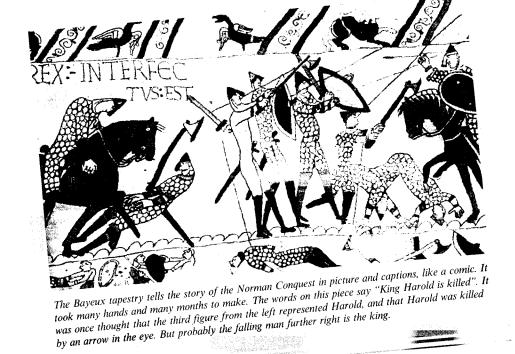
- •CONTENTS
- •BRITAIN IN MIDDLE AGES 13
- •ANCIENT BRITAIN
- •Had Harold waited and given his army a rest, the outcome of the battle might have been different.
- •BRITAIN IN MIDDLE AGES
- •early middle ages
- •later middle ages
- •Key words, terms and concepts
- •Anglo-Norman Britan
- •Later Middle Ages
- •Britain in Late Middle Ages
- •THE STUARTS AND THE STUGGLE OF THE PARLIAMENT AGAINST THE CROWN
- •THE 18тн CENTURY–OF WEALTH, TECHNOLOGICAL REVOLUTION AND POWER
- •Содержание

Alfred the Great saved England from the Danish conquest, but in the 10th– 11th centuries the Danes managed to expand their possesion in Great Britain and from 1013 to 1042 the Danish royal power triumphed in England. King al power triumphed in England. King Canut's empire included Norway, Denmark and England. In 1042 the house of Wessex was restored to power in England, when Edward the Confessor was elected king by the Witan. He was half-Norman, had spent his exile in Normandy, and Wiffiam the Duke of Normandy was his cousin and a close friend.
Edward the Confessor was a religious monarch and devoted his attention to the construction of churches and most of all to the building of Westminster Abbey.
Edward the Confessor died in 1066 without an obvious heir. And the Witan elected Harold, a Saxon nobleman from the family of the Godwine, the king of England. Harold's right to the English throne was challenged by William the Duke of Normandy who claimed the English Kingdom as his rightfull inherit ance which had been alledgedly promised to him by the late King Edward the Confessor.
1066 was a crucial year for the Saxon King, and for the history of the English.
Harold had to fight against two enemies at the same time. In the South William of Normandy was preparing to land in England, in the North, in Yorkshire, the Danes renewed their attacks against England.
Harold succeded in defeating the Danes and rushed his armies back to the South to meet William who had landed near Hastings. His men were tired, though they had done so well in the battle against the Danish vikings. William's army was better armed, better organized and he had cavalry.
Had Harold waited and given his army a rest, the outcome of the battle might have been different.
But after a hard and long struggle Harold and his brothers were killed in the battle of Hastings and the flower of Saxon nobility lay dead together with them on the battle field.
The Bayeux Tapestry (231 feet long 19 inches wide) tells a complete story of the Norman Conquest of Saxon England in over seventy scenes. In one of the scenes the Latin writing says "Harold the King is dead", and under the inscription stands a man with an arrow in his eye believed to be King Harold.
William captured London and was crowned King of England in Westmister Abbey on Christmas Day, 1066. The Norman period in English history had begun.
Some historians argue concerning possible ways of English history, had the Anglo-Saxons defeated William. But History doesn't rely on the Conditional Mood.
All the invasions, raids and conquests were contributing new and new waves of peoples to be integrated into a newly appearing nation of the English, to understand which we must know its historical roots, studying historical facts.
Questions:
13
1.What is traditionally said about the geographical position of Britain? What do you think of it?
2.What material monuments of Pre-Celtic population culture still exist on the British territory?
3.Which of the Celtic tribes gave their name to their new home-country?
4.What functions were performed by Celtic Priests? What were they called?
5.Which Roman expeditions were successful in subjugating Britain and when? Was it a peaceful development?
6.What are the well-recognized contributions of Roman civilisation to British culture?
7.Did King Arthur and his Knights of the Round table exist and when if they did?
8.What Germanic tribes invaded Britain from the Continent and what states emerged as a result of that invasion?
9.What was the historical role of the Vikings on the British Isles?
10.Which of the Anglo-Saxon kings rightly deserved the title of Great? What were his great accomplishments?
11.In what way was Edward the Confessor responsible for William's claim to the English crown?
12.What: is the name of the battle which is a historic turning point for England?
14
